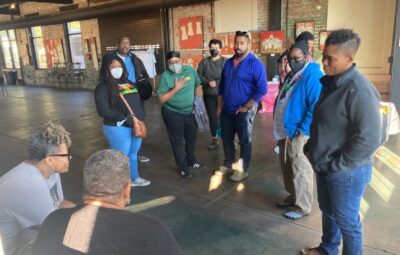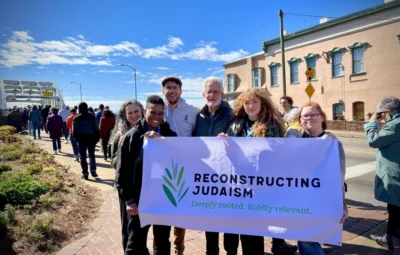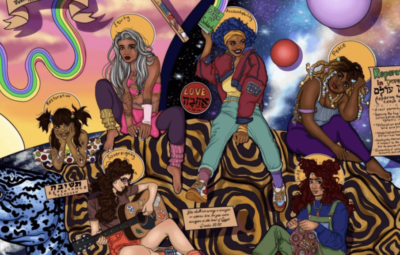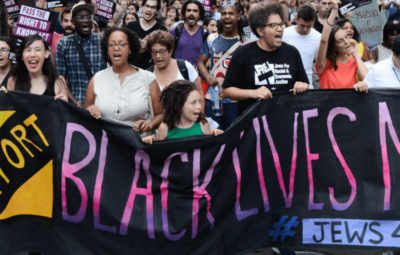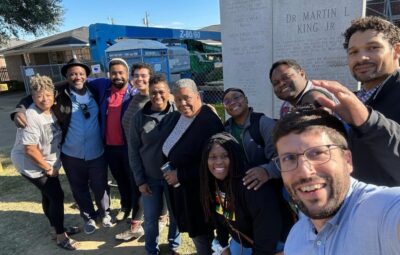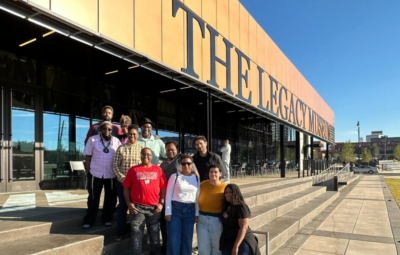Reckoning Together: A Reconstructionist Pilgrimage Towards Racial Justice
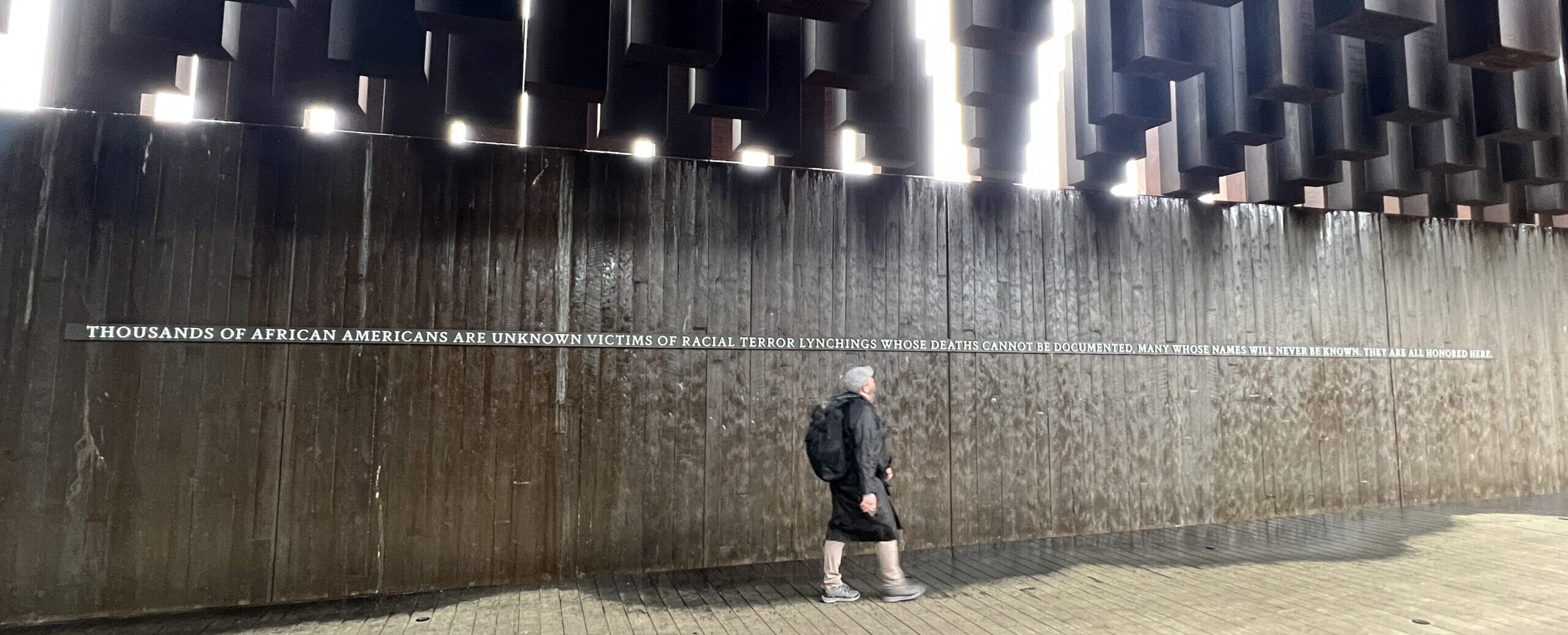
“Ain’t gonna let nobody turn me ’round,
turn me ’round, turn me ’round,
Ain’t gonna let nobody turn me ’round
I’m gonna keep on a walkin’, keep on a-talkin’,
Marching up to freedom land.“
-freedom song based on the spiritual “Don’t You Let Nobody Turn You Round”
and became an American civil rights era anthem
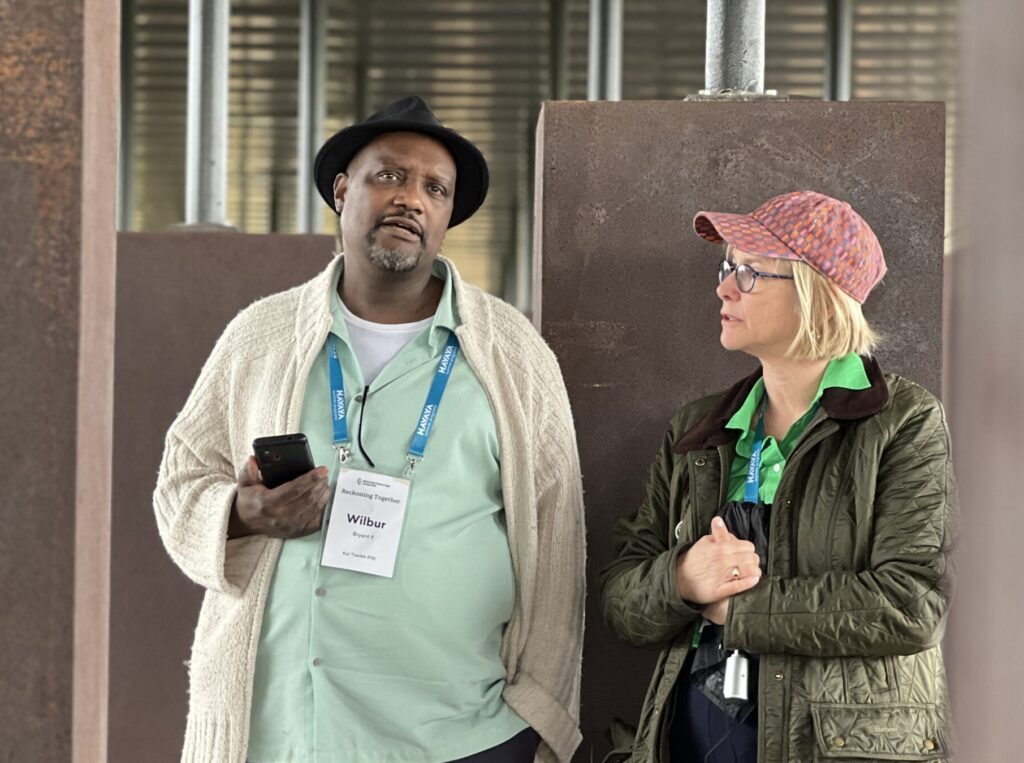
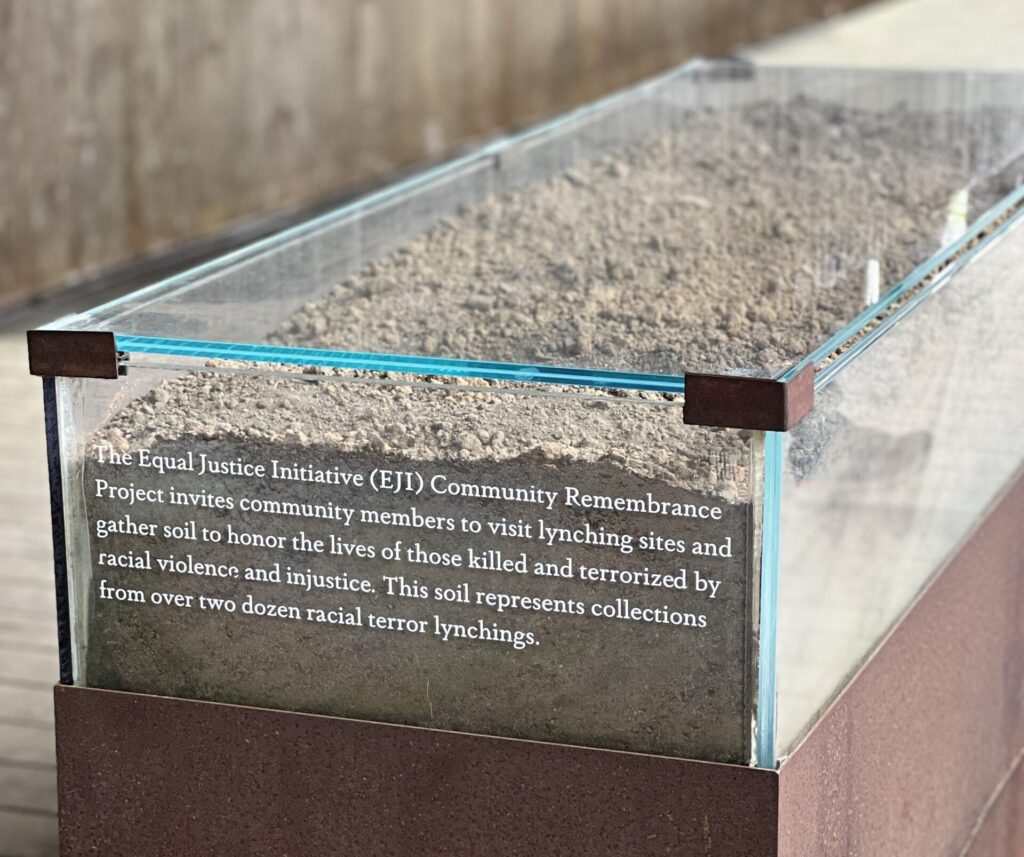
Among the key sites were the National Memorial for Peace and Justice and Legacy Museum: From Enslavement to Mass Incarceration. Both tell the story of slavery, lynching, Jim Crow segregation and mass incarceration while simultaneously celebrating resistance, the struggle for justice and hope.
“Reckoning Together” came on the heels of an earlier pilgrimage for Jews of African descent. A number of participants on the earlier pilgrimage returned.
This page captures the sights, sounds and energy of an extraordinary pilgrimage. We invite you to explore and be part of our efforts to join and lead efforts to dismantle systemic racism.
Watch Our Journey
Reckoning Together, Part 1
Opening Program in Atlanta, GA
Rosa Parks Museum, National Memorial for Peace and Justice and neighboring Legacy Museum in Montgomery, AL
Shabbat in Selma, AL
Reckoning Together, Part 2
Miss Joanne Bland, walking across the Edmund Pittus Bridge, and bus tour in Selma, AL
Shabbat Luncheon at Reform Temple Emanuel in Birmingham, AL
Reckoning Together, Part 3
Ebenezer Baptist Church, The King Center and Closing Program in Atlanta, GA
Read Reflections of Those on the Pilgrimage
This week, we have reached the end of Shmot. The first part of the Book of Exodus is all narrative. We trace the trajectory of the enslavement of the people Israel to our liberation from slavery—not to do anything we want but to go from brute avodah, harsh and meaningfulness work, to holy avodah, to enter into service to Adonai. And so we march directly to Sinai to receive revelation.
Avadim hayyinu, we were slaves, and then we became a covenanted holy people. This is the foundational story of the Jewish people. This is the animating impulse of activism of so many Jews, whether we are inspired by the Exodus story or by its interpretation at the Passover seder, where we say ha lakhma anya, “Let all who are hungry come and eat,” where we are commanded to tell the story as if I myself were liberated from slavery.
The Book of Exodus recounts the revelation at Sinai, this powerful encounter with God, a moment of such intensity that the Israelites experienced synesthesia, where they saw thunder and heard lightning, where they agreed na’aseh venishmah, to do and to understand, which is one of the values of our pilgrimage. We then read about the halakhot that God handed down, in the service of building covenantal community and fostering holy relationships beyn adam lemakom, between humans and God, and beyn adam lehavero, amongst humans.
And then the last five parshiyot of Exodus are about building the mishkan, that portable tabernacle that would travel with the Israelites in the desert. These Torah portions provide detailed blueprints, but there is dramatic narrative as well. Last week, in Ki Tissa, we read about the Golden Calf, and I hope you all had a chance to read Mark Pinksy’s beautiful dvar torah that we sent out earlier this week. This week’s parshah is about recovery from that episode, it’s about teshuvah (repentance), renewal, and completion of the mishkan, where each person contributed in their distinctiveness, and which was crafted to meticulous and beautiful standards.
I want to share three attributes of the mishkan that may be meaningful to you on this shabbat as we experience this pilgrimage and as we consider how to take this experience home.
The first draws on the very word itself, mishkan. Hebrew is a building-block language and you can build nouns and verbs from the root letters. The root of mishkan is shin-kaf-nun. It’s the same root as shakhen, neighbor. It’s the same root as shekhunah, neighborhood. The root of the word for mishkan is about centering relationships; it’s about cultivating intimacy; it’s about recognizing the holiness in connection. This is always potent, and especially so for us, as a op up community seeking to bring God’s presence into our midst and into the world, which is why we adopted “kehillah kedoshah,”holy community, as part of our covenant of behavior. The covenant of behavior and the values that we shared out are there to help guide us this weekend to be our best selves. And of course, these letters form another word, Shekhinah, the feminine manifestation of the divine that accompanied the Israelites in their wanderings. This teaches powerfully that in relationship we can experience, we can manifest the divine. As Martin Buber taught, “When two people relate to each other authentically and humanly, God is the electricity that surges between them.”
The second attribute focuses on a design feature of the mishkan, the keruvim or, in English, cherubim, that kind of foreign decoration on all four corners at the top of the ark that is some kind of winged creature—think of the depiction in Raiders of the Lost Ark. Whatever they are, I want to call your attention to the space created between them. Rabbi Alex Weissman (RRC 2007) teaches, “It is in this space between the keruvim that the Shekhinah is most imminent, in this space of sacred relationship and witness, around which the community gathers and performs sacred ritual. The Kli Yakar [16th century Czech rabbi] teaches about this sacred space, “The Divine light radiated outward from the ark affecting everything around it. Thus the Sages say that [the ark] actually bore those who appeared to bear it” (Kli Yakar on Ex. 25:22). This is how our community ideally functions. We have the experience of both seeing and being seen, we experience God’s presence emanating from this space of witness and connection, and from that source of holiness, we are buoyed rather than burdened.”
This is what we aspire for how we act with each other, in this room, on this pilgrimage. This is what we aspire for the world—the capacity to see and experience and celebrate God’s presence in each and every person. And that’s what this reckoning is in the service of. While ultimately dealing with the implications of the decimation of indigenous populations and 400 years of chattel slavery is a structural matter, we must do so in order to bring to life that world where the tzelem Elohim (image of the divine) of every person is recognized and can shine out.
Finally, the Talmud (Bava Batra 14b:6-7) teaches that the kohanim, the priests, placed two sets of tablets inside the mishkan, both the whole ones that Moshe brought down from Sinai after the Golden Calf, and the first set that he broke. This is always a powerful story, and it feels especially resonant on this pilgrimage. We are witnessing profound injustice and its lasting impact. We must recognize the brokenness and reckon with it. We do so always holding the hope of wholeness. We must live with the paradox that we all, individually and as a society, toggle back and forth between whole and broken. Sabrina Sojourner shared this powerful quote by Maxine Hong Kinston, from her amazing book The Woman Warrior, “I learn to make my mind large, as the universe is large, so that I can hold paradox. “ Sabrina remarked to me this afternoon: “We really know now how huge the universe is.”
Elsewhere in the Talmud, in Pesakhim 54a, we learn that God created teshuvah before God created the world. This means that there is always a pathway back. We will encounter brokenness, we will sometimes be responsible for the breaking or we will fail to act—and through teshuvah, in community, we can orient ourselves toward and work for healing and wholeness.
In the book of Exodus, we see the trajectory ma’avdut leherut, from oppression to liberation. We see multiple examples of sinning and of teshuvah. We are taught the rules for and practices to build covenantal community. We read about paradox and tension, about brokenness and wholeness. With the building of the mishkan, we learn about God’s presence and the centering of relationships. These are resources for all of us as we take in and process the experiences of this pilgrimage, as we ultimately disperse from this pop-up community and go home, as we integrate insights into our Passover celebration, as we continue our activism into the future. May you draw deeply on Jewish wisdom and may you contribute your own insights. This is how we as the Jewish people build up the Jewish civilization. This is how we support each other in our work of reckoning, in our work toward repair and justice.
Upon the conclusion of reading a book of Torah, it is the custom to chant, Hazak hazak venithazek, Be strong and may we be strengthened. Let us chant together…
Rita and I recently spent one of the most impactful weekends of our lives. Friends of ours belong to a Reconstructionist synagogue and asked us to join them on a ”pilgrimage” to the Deep South entitled, “Reckoning Together: A Reconstructionist Pilgrimage Towards Racial Justice”.
For the last ten years that we lived in southern California, we were members of a Reconstructionist congregation, University Synagogue in Irvine. We adored the congregation, and were “all in” with the Reconstructionist slant on Judaism, so we were very comfortable heading out on this adventure, even though we are not currently affiliated with Reconstructing Judaism.
During the late 1960’s we were busy finishing college, getting married and starting out in life. While we were certainly aware of the Civil Rights movement, it seemed very distant from us and we were supportive, but definitely not a part of the movement. When I look back on my life I can understand why I had not been involved. Nonetheless, I have always felt a bit of a loss that I lived through this momentous period and never did anything significant to help, and I have always wanted to better understand that period of time. Knowing that one of Reconstructing Judaism’s primary commitments is working for racial justice assured me that this would be a slant on the issue that I would find educational and constructive. . According to their website;
“Fighting for racial justice is a top priority for Reconstructing Judaism and is a natural extension of our Jewish values. The Torah’s very first and most central description of human beings is that we are all created b’tzelem Elohim — equally and uniquely in the image of God.”
It is hard to convey in words what this weekend was all about and how I feel I have been transformed, but I thought it worth a try, so here goes. We were a group of about 200, mostly, but not exclusively Reconstructionist Jews. About 15 of us were people of color. It was clear that this cohort was experiencing the events much differently than I was, and having them with us added another unique dimension to the experience.
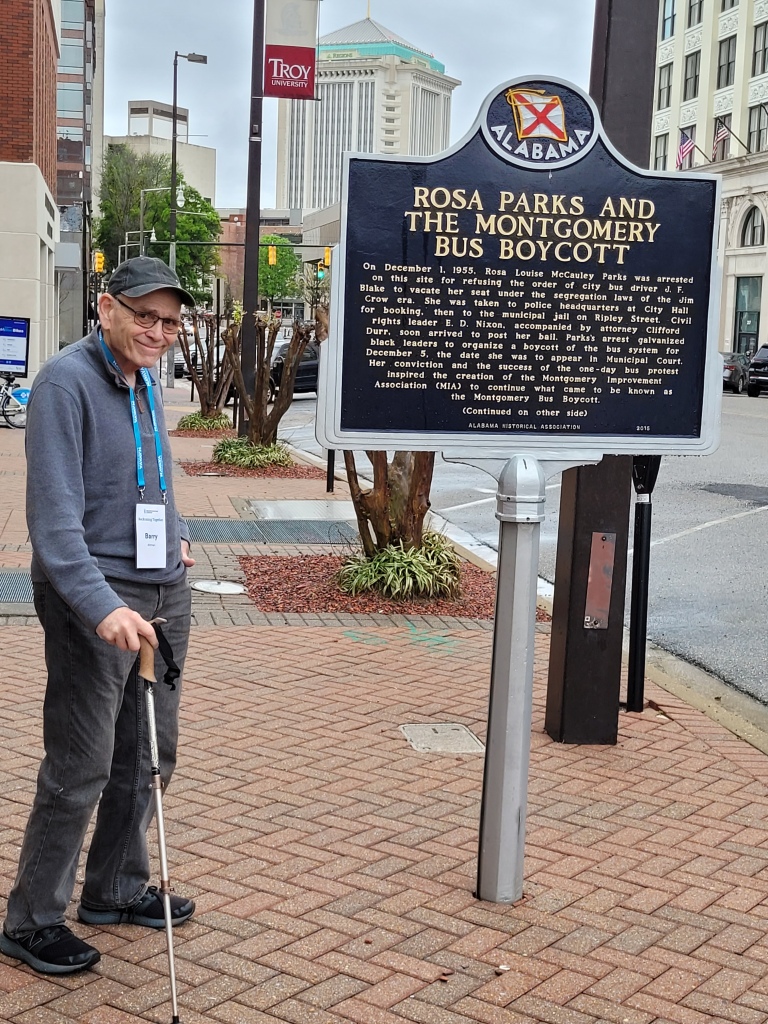
We gathered together for an opening program in Atlanta on Thursday night, and headed out bright and early on Friday in four buses for Montgomery. The capital of AL, Montgomery has also become the unofficial capital of the Civil Rights Movement. The Movement is generally agreed to have begun on Thursday, Dec. 1, 1955 when Rosa Parks refused to give up her seat to a white man on a Montgomery public bus. Over 90% of the bus system’s ridership consisted of African-Americans, so when the Black community organized a boycott starting the following Monday, the system was brought to its knees financially. Court battles ensued, and a year later segregation on public buses in this country was declared illegal when the U.S. Supreme Court upheld a lower court decision in the case of Browder v. Gayle, declaring bus segregation to be a violation of the equal protection clause of the Fourteenth Amendment of the U.S. Constitution.
Most of us learned as children that Rosa Parks was a quiet, unassuming seamstress who was riding the bus on her way home from work and simply became fed up and decided bravely – and probably on the spur of the moment – not to give up her seat. At the Troy University Rosa Parks Museum in Montgomery we learned “the rest of the story”. We learned how Ms. Parks had been trained as an activist and how her actions and the ensuing organization and execution of the boycott along with the legal actions were all part of a carefully orchestrated plan. Churches played an integral role, fundraising and buying station wagons to provide transportation. People learned to walk long distances to work. The buses were essentially empty.
A young minister had recently come to town as pastor of the Dexter Avenue Baptist Church and became the leader of the boycott. The Rev. Dr. Martin Luther King, Jr. thus burst onto the national scene. The church, known since 1978 as the Dexter Avenue King Memorial Baptist Church was acknowledged to be the “backbone” of the boycott, which was considered to be the first locally-initiated mass protest against racial discrimination and a model for other grass-roots demonstrations.
While in Montgomery, we also visited the Equal Justice Initiative’s Legacy Museum where we traced the enslavement of Africans captured and brought to America starting in the 1600’s and continuing into the 19th century. On the one hand, we all knew what had occurred. But on another level, we had no idea what had happened. The Legacy Museum does such an amazing job of bringing home the enormity of the barbarism that has been perpetrated as to make any thinking human open their eyes and rethink everything they ever believed about the history of our country. The numbers were staggering. For instance, I never knew that 2,000,000 Africans died over the years while in transit across the ocean. Think of the enormity; that is nearly four times the population of Washington, DC. The museum also drives home the fact that the persecution continues today.
I noticed the term “slavery” was seldom used, but was replaced with “enslavement”. I thought about this, and it suddenly made perfect sense. Slavery connotes a condition people may have found themselves in. Enslavement says what actually happened; one group of people placed another group into bondage.
As Jews preparing for Passover, we read about having been “slaves in Egypt”. I won’t get into the historical accuracy (or perhaps lack thereof) of that story, but the enslavement, eventual freeing and ultimate exodus of the Jewish people from Egypt is central to our history. What happened in this country was far worse. It is arguable that the success of the United States has largely been attributable to the economic advantage reaped from the enslavement of Blacks. I had always wondered how it could possibly have taken so long for emancipation, and why it would have taken a Civil War. And I continue to be confounded by the ongoing racism that continues to this very day. At the Legacy Museum the sheer economics suddenly struck me. Many, many, many people built fortunes based on slave labor.
Never mind the declaration of Independence; “We hold these truths…that all men are created equal,…” Never mind the Preamble to the Constitution; “… in Order to…secure the Blessings of Liberty to ourselves and our Posterity.” Never mind Lincoln’s Gettysburg address; “…our fathers brought forth on this continent, a new nation, conceived in Liberty, and dedicated to the proposition that all men are created equal.” Until this very day people fear “the other”, and worry about being “replaced”, and when they can, they continue to take economic advantage. Just look up average pay for similar work for men versus women or whites versus people of color.
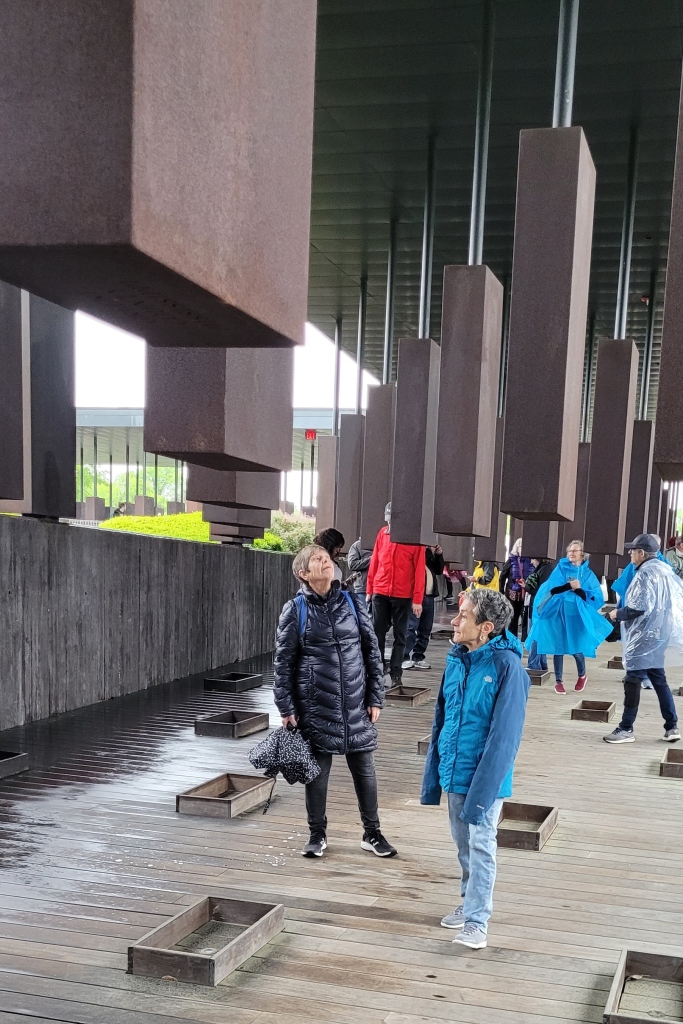
We also visited EJI’s new National Memorial for Peace and Justice, colloquially referred to as the “lynching museum”. According to the EJI website, “More than 4,400 African American men, women and children were hanged, burned alive, shot, drowned, and beaten to death by white mobs between 1877 and 1950.” The”lynching museum” uses casket sized metal boxes, one for each county, with the name of each victim and the date of their lynching engraved on it. Every death has been meticulously researched and verified, with two independent sources required for each entry. The resulting visual is overwhelming. While we had all known of lynchings, once again we were all overtaken by the enormity of the terrorism that had been committed for so long.
The next morning we left for Selma where we met with Ms. Joanne Bland, a civil rights hero who was arrested 15 times between ages 8 and 11 and who marched on Bloody Sunday, March 7, 1965 (aat the age of 11). On that day, future GA congressman John Lewis and Hosea Williams led 600 marchers across the Edmund Pettus Bridge over the Alabama River leaving Selma and starting a planned 54 mile march to Montgomery, where they planned to demand that Governor George Wallace address their grievances. In Selma and surrounding Dallas County, the population was over 50% African-American, yet Blacks accounted for less than 2% of registered voters., On the other side of the bridge, the marchers were brutally attacked by state troopers and local sheriff’s deputies. News film of that massacre was flown to New York and shown during prime time, raising public awareness to a heightened level. Having obtained a court order permitting the protest, the marchers left Selma again on March 21, this time under the protection of federalized National Guard Troops. Thousands joined the march, and the crowd that finally arrived at the capitol in Montgomery had grown to 25,000. The events of that day are generally credited as having galvanized public opinion leading directly to the passage of the Voting Rights Act, signed into law by President Lyndon Johnson on August 6, 1965.
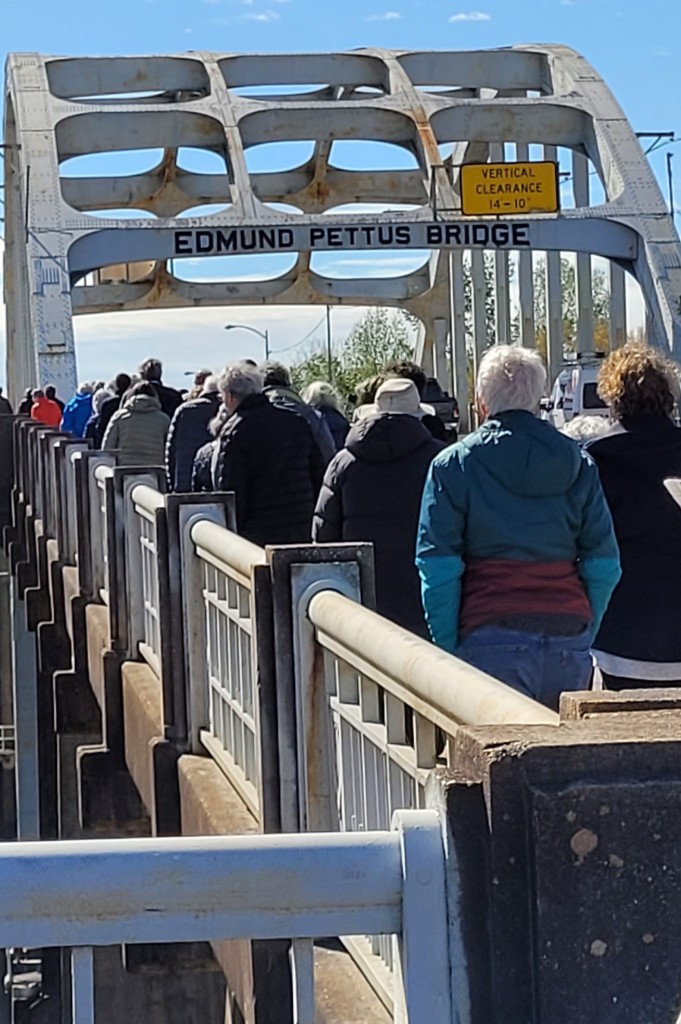
I can’t begin to describe the emotions as we walked across that bridge. We were mostly silent, or talking in whispers. There were lots of tears. Having spent time with Joanne Bland and then immediately following her footsteps over that bridge was simply indescribable. As we reached the apex of the bridge and looked to the other side, we could all envision the lines of baton-carrying troopers and deputies just waiting to attack.
And there was so much more. We drove from Selma to Birmingham where we met with Bishop Calvin Woods, Sr., a 90 year old civil rights leader who worked with MLK, John Lewis and the others. While in Birmingham we also paid our respects at the 16th St. Baptist Church where four young girls died in a bombing in September, 1963. We returned to Atlanta and were honored to attend a Sunday morning service at the Ebenezer Baptist Church. Of course we also drove by MLK’s childhood home and paid respects at his gravesite.
I am left with so many thoughts and so many questions. With your indulgence, I will write more on this experience discussing questions like;
- How do we teach this history? (Some are questioning if we should teach this history.)
- What progress have we made? What work do we still have to do?
- What can I do to make a difference?:”
- What can I do to encourage others to make a difference?
- How do we effect real change for the future?
- What do we tell our kids?
Throughout the entire weekend, I kept thinking that every teenager in America should be afforded this experience. What do you think?

